
The Legion of Super-Heroes is a fictional superhero team appearing in American comic books published by DC Comics. Created by writer Otto Binder and artist Al Plastino, the Legion is a group of superpowered beings living in the 30th and 31st centuries of the DC Comics Universe, and first appears in Adventure Comics #247.

Brainiac is a supervillain appearing in American comic books published by DC Comics. Created by Otto Binder and Al Plastino, the character debuted in Action Comics #242 in July 1958. He is usually depicted as an extraterrestrial android or cyborg who serves as one of Superman's greatest enemies and a frequent adversary of the Justice League. Brainiac is known for shrinking and stealing Kandor, the capital city of Superman's home planet Krypton, and is even responsible for Krypton's destruction in some continuities.

Booster Gold is a fictional superhero appearing in American comic books published by DC Comics. Created by Dan Jurgens, the character first appeared in Booster Gold #1 and has been a member of the Justice League.

Brainiac 5 is a fictional superhero character who exists in the 30th and 31st centuries of the DC Universe. He is from the planet Colu and is a long-standing member of the Legion of Super-Heroes.

Saturn Girl is a fictional superheroine appearing in American DC comic books. A talented telepath from the 30th century, Saturn Girl is a founding member of the Legion of Super-Heroes and also she is the youngest member for the Justice League. Imra's "Saturn Girl" title refers to her homeworld of Titan, the largest moon of the planet Saturn.
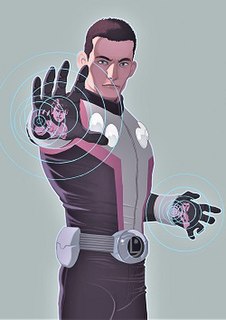
Cosmic Boy is a fictional character, a comic book superhero in the 30th and 31st centuries of the DC Comics Universe. He is a founding member of the Legion of Super-Heroes, and was the original leader in all incarnations of the Legion.
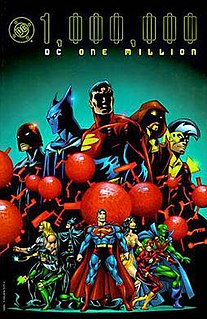
DC One Million is a comic book crossover storyline that ran through a self-titled, weekly miniseries and through special issues of almost all of the "DCU" titles published by American company DC Comics in November 1998. It featured a vision of the DC Universe in the 853rd century, chosen because that is the century in which DC Comics would have published issue #1,000,000 of their comics if they had maintained a regular publishing schedule. The miniseries was written by Grant Morrison and drawn by Val Semeiks.

Rip Hunter is a fictional superhero appearing in American comic books published by DC Comics. Created by writer Jack Miller and artist Ruben Moreira, the character first appeared in Showcase #20. Following three more appearances in Showcase, Rip Hunter was given his own series which ran for 29 issues (1961–65). He later starred in the eight-issue Time Masters series (1990), written by Bob Wayne and Lewis Shiner. After numerous revisions and following the events of the 2005 "Infinite Crisis" storyline, Hunter is established as the son of Booster Gold.

Justice is a twelve-issue American comic book limited series published bimonthly by DC Comics from August 2005 through June 2007, written by Alex Ross and Jim Krueger, with art also by Ross and Doug Braithwaite. Its story involves the superhero team known as the Justice League of America confronting the supervillain team the Legion of Doom after every supervillain is motivated by a shared dream that seems to be a vision of the planet's destruction, which they intend to avoid.

Legion of Super Heroes is an American animated television series produced by Warner Bros. Animation, adapted from the DC Comics series of the same name. It debuted on September 23, 2006, and centers on a young Superman's adventures in the 31st century, fighting alongside the eponymous group of superheroes. The show was produced by one of its main character designers James Tucker, a co-producer of the Justice League Unlimited series, for the Kids' WB line on The CW network.
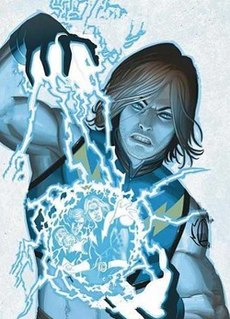
Garth Ranzz, also known as Live Wire and Lightning Lad, is a fictional comic book superhero appearing in books published by DC Comics, usually those featuring the Legion of Superheroes, a 30th and 31st century group of which he is a founding member. He has the superhuman ability to generate electricity, usually in the form of lightning bolts.
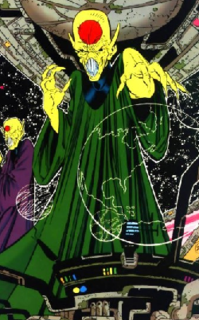
The Dominators, collectively known as the Dominion, are a fictional alien race appearing in comics and other media by DC Comics. Coming from the outer cosmos of the DC Universe, they are highly technologically advanced, and live in a rigid hierarchical society, in which one's caste is determined by the size of a red circle on one's forehead. They are master geneticists who can manipulate the metagene to enhance members of their own caste.
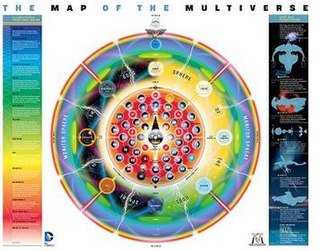
The Multiverse, within DC Comics publications, is a "cosmic construct" collecting many of the fictional universes in which the published stories take place. The worlds in this multiverse share a space and fate in common, and its structure has changed several times in the history of DC Comics. The Multiverse was originally created by Perpetua, who is the mother of the Monitor, Anti-Monitor and World Forger.
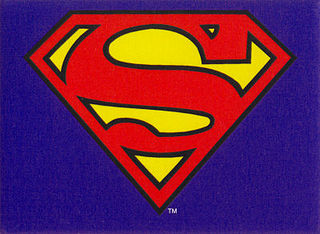
The fictional superheroine Supergirl has been adapted into pop culture several times since 1984. This includes a feature film and several animated and live-action television programs.
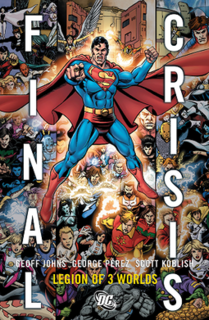
Final Crisis: Legion of 3 Worlds is a five-issue 2008 limited series produced by DC Comics. The series is a tie-in to Final Crisis. It is scripted by Geoff Johns, and drawn by George Pérez.
Super Juniors are a group of fictional DC Comics characters based on members of the Justice League of America, designed as baby versions in order to appeal to younger audiences and introduce them to the publisher's most popular properties. At Kenner's request, first appeared in José Luis García-López's 1982 DC Comics Style Guide and had their first and only adventure in Super Jrs. Holiday Special: The Best of DC Blue Ribbon Digest #58 in a story written by Tom DeFalco and drawn by Vince Squeglia. There was a considerable amount of merchandise based on them.
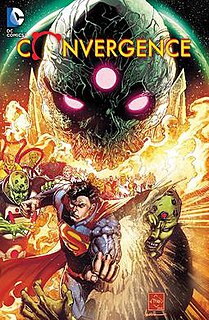
"Convergence" is a weekly comic book storyline published by DC Comics that ran from April 2015 to May 2015. The series consists of an eponymous No. 0 issue, an eight-issue core miniseries, and 40 two-issue tie-in miniseries. "Convergence" continues from the weekly series Earth 2: World's End and The New 52: Futures End. In the story, Brainiac collects cities and inhabitants from various timelines that have ended and traps them in domes on a planet outside of time and space. He then exposes the domes to one another to see how the characters interact. This event marks the return of DC characters and timelines from before the 2011 "Flashpoint" storyline that led to the creation of The New 52 Universe.

Lego DC Comics Super Heroes: Justice League – Cosmic Clash is an computer-animated action comedy film based on the Lego and DC Comics brands, which was released on February 9, 2016 on Digital HD and March 1, 2016 on Blu-ray and DVD. It is the fifth Lego DC Comics film following Lego Batman: The Movie – DC Super Heroes Unite, Lego DC Comics: Batman Be-Leaguered, Lego DC Comics Super Heroes: Justice League vs. Bizarro League and Lego DC Comics Super Heroes: Justice League – Attack of the Legion of Doom. Some actors from various DC properties reprised their respective roles, including Nolan North as Superman and Khary Payton as Cyborg. The film received positive reviews, with critics deeming it superior to past films in the Lego DC Comics film series.

















